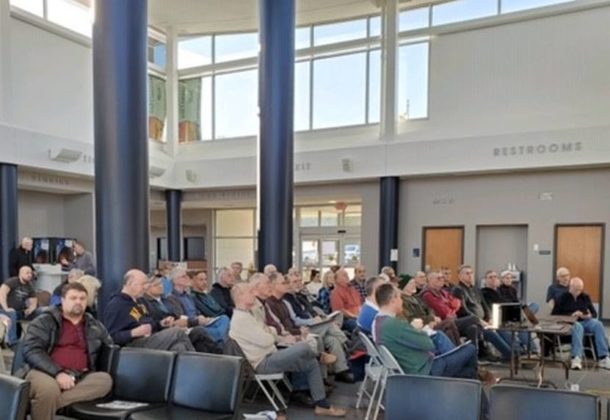Rusty Pilot Update Draws 50 Pilots

If all of aviation got together to compose a shared recruitment poster it might be aimed at a Rusty Pilot, that is, a pilot whose credentials have lapsed. They are being recruited back to active flying to help sustain an industry suffering a pilot shortage impacting the military, commercial aviation, and general aviation as well.
“A lot want to do it,” says James Alexander, chair of the St. Mary’s County Regional Airport Board, as well as an FAA Safety Team Representative. He is helping make that easier to do for Rusty Pilots in Southern Maryland.
The loss of general aviation pilots prompted the Aircraft Owners and Pilots Association (AOPA) to develop the Rusty Pilot Program, which is part of a number of efforts to bring lapsed pilots current.
St. Mary’s County Regional Airport hosted its first Rusty Pilots instructional course one morning this month. Fifty pilots showed up and earned instructional credits for both the morning session and from two of the FAA’s WINGS Pilots Proficiency Program presentations in the afternoon.
Decreasing numbers of pilots “have a cascading effect,” Mr. Alexander says about the importance of outreach efforts for new and returning pilots. It is felt in general aviation and recreational aviation with a loss of instructors and maintenance workers – a shortage of “flying and fixing,” he says.
“The number of pilots is decreasing as the population is increasing.” Mr. Alexander explains. Fewer pilots mean fewer young people are introduced to the possibilities of aviation as a career. And it is a great career choice, offering broad opportunities, including the new field of unmanned flight.
Piedmont Flight Center owner and flight instructor Dave Stanton agrees with Mr. Alexander and most others in aviation, bringing young people to aviation will result in more new pilots. As Mr. Stanton grows Piedmont’s flight school at St. Mary’s Airport, he is initiating efforts into St. Mary’s County public schools to introduce aviation and flying.
“We benefit here with Pax River” that young people are aware of aviation careers, he says. But still, many don’t think to explore flying unless a family member is already involved.
It is absolutely not necessary to have a history of aviation in your background, nor do you have to be rich to fly, says Piedmont’s chief instructor Mark Boas. There are pilots at St. Mary’s County Regional Airport from age 15 to 85. “It’s fun for everybody,” Mr. Stanton agrees.
And it can be a lifelong vocation or avocation. A pilot earns his license for life, but there are requirements to remain current. “I was a Rusty Pilot,” says Mr. Alexander. “It’s not that hard to get back into it.”
He and Airport Manager Allison Swint worked with the AOPA to get the Rusty Pilots course scheduled alongside two of the FAA’s WINGS Pilot Proficiency Program presentations. The WINGS program helps pilots keep their flying knowledge and skills honed with recurrent training that is mostly free, Mr. Alexander says. The knowledge qualifications within the FAA program accept Rusty Pilot credentials as well.
The three-hour Rusty Pilot program, conducted by an AOPA instructor, takes pilots through a learning/training session via a scenario flight – the program at St. Mary’s Airport used a flight within Florida. As the scenario unfolds the current regs, references, and technologies are discussed.
Pilots receive an endorsement for their log books for completing this ground portion of the Flight Review. And it counts for FAA credentialing. Flight Reviews are required of active pilots on a regular basis. Piedmont Flight Center at St. Mary’s airport is certified to conduct the Flight Reviews pilots require. Piedmont helped sponsor the instructional programs this month and Mr. Alexander praised the organization for its generous Flight Review discount and free lunch offered the attending pilots.
“We let the pilot tell us what’s rusty,” Mr. Stanton says of the Flight Reviews. “It’s whatever they need.” There have been a lot of changes in flight restrictions. And there have been a lot of changes in technology. All of these are apparent and available for pilot review and learning sessions. The most gargantuan change, agree the pilots, is the iPad.
“There’s an app,” Mr. Stanton says.
“It’s everything you need to prepare and file flight plans, check weather, develop navigational charts, and even review fuel pricing along your course,” says Mr. Boas. Piedmont students still have to plot their first course on paper, so they understand what it is the iPad does for them.
Piedmont Center also offers Discovery Flights if you would like to spend a hands-on 45 minutes in a plane with a qualified flight instructor. Contact Piedmont at 240-718-8001 or [email protected].
For pilots, another training day is scheduled at St. Mary’s County Regional Airport on March 14, 2020. The presentations will include a pilot forum with the FAA and two WINGS programs. That morning the Southern Maryland Experimental Aircraft Association’s VMC club will be meeting as well. VMC (visual meteorological conditions) is a flight category where pilots have sufficient visibility to see the terrain and other aircraft. The EAA’s VMC Clubs offer meetings for recreational pilots to share knowledge and experience using real-world scenarios and also provide WINGS credit.
To learn more about opportunities at St. Mary’s County Regional Airport, 44174 Airport Road, California, MD 20619, contact Ken Reed ([email protected]) of S. Hunt Aero. To learn more about S. Hunt Aero, visit its Leader Member Page.























